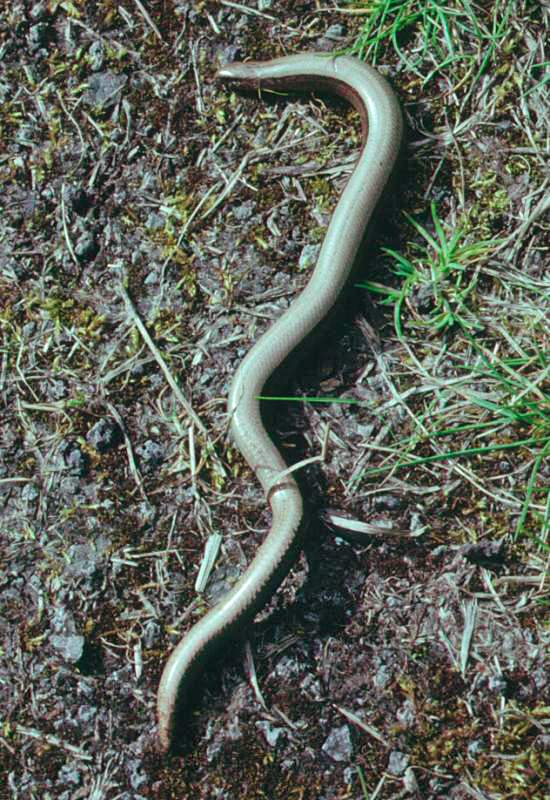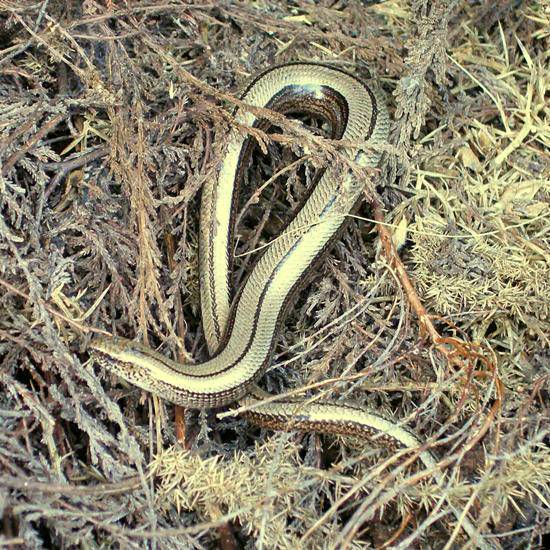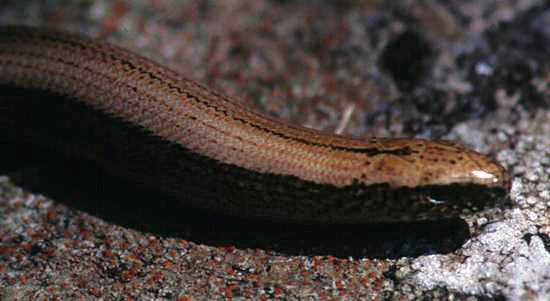Trees Birds Mammals Fish Amphibians Reptiles
Wild Algarve
Bookshop
Anguis fragilis - Slow worm
Phylum: Chordata - Class: Reptilia - Order: Squamata - Family: Anguidae
Identification - Distribution - Lifecycle - Food - Predators - Reference Sources

Although they look very much like snakes, Slow Worms are
in fact legless lizards.
Identification
The most distinctive feature of the Slow Worm is an almost complete
absence of identifying markings on the body, although some females are
found with a thin dark stripe along the back. Slow Worms vary quite a lot in
colour, from a bright coppery brown to a leaden grey. The females tend to be
brownish, while the males are usually more grey; both are quite shiny in
appearance. As with the other lizards, they have eyelids and are
able to blink and to close their eyes when resting; snakes, on the other hand, have no
eyelids.

Distribution and Habitat
Found across most of Europe and Asia, this burrowing reptile spends much of the time either under rocks, tree branches or other objects lying on the ground or in shallow holes in soft dry soil. They are often found by gardeners who are turning over material in their compost heaps. You will usually find slow worms only in places where there is
plenty of cover: in the open they can sometimes be seen crawling among long dry grass or amidst soft soil and
undergrowth with somewhere nearby where they can sun themselves but almost
always close to a bolthole - a rock hollow, a fallen branch or (very often) discarded sheet metal.

Female Slow Worm
When old corrugated iron sheets are left
beside buildings, Slow Worms are very likely to take up residence there, and they
will even hibernate in such places.
Food
Slow Worms are popular with gardeners who are 'in the know' because they eat slugs and snails. They are also partial to worms, spiders and any insects they can catch.
Predators
These harmless reptiles are sometimes eaten by snakes and by larger birds; however they probably have most to fear from humans who mistake them for snakes and kill them in the mistaken belief that they pose a serious threat to their families.
Note that all native lizards (and snakes) in Britain are protected by law, and it is an offence to harm them in any way - including offering them for sale. Please leave them alone, and maybe we can halt what has been a remorseless decline in their numbers in recent times.
Lifecycle
Like other reptiles, Slow Worms hibernate during the cold winter moths. In Britain they emerge from hibernation in March, and by late May they have come into condition ready for their breeding season.
Slow Worms are viviparous (giving birth to young in a thin membrane that bursts to release the young as soon as they emerge from their mother), usually in September or October. Brood numbers range from 3 to more than 20, and the young, which are pale golden brown on top with greyish silver undersides and typically 8 or 9cm long, take about three years to reach maturity.
Adult Slow Worms can live for up to 30 years in the wild and even longer in protected captive environments, and they can reach a length of 40 to 50cm.
Reference Sources
Matching the Hatch by Pat O'Reilly (2017) - learn all about aquatic insects and other small water creatures that feature in the diet of reptiles.
Acknowledgements
This page includes pictures kindly contributed by Simon Harding and Bob Osborne.